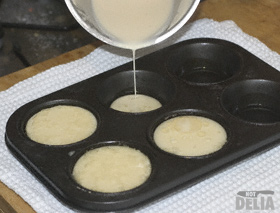 [Here’s a link to the recipe, method and photos for making Yorkshire Puddings]
[Here’s a link to the recipe, method and photos for making Yorkshire Puddings]
I bought a new silicone Yorkshire pudding tray recently, and asked around to see if anyone had used such a thing. Not many people had, but of those few, the comments weren’t very favourable. Mostly they complained that the puddings stuck or the silicone tray was difficult to handle because it was too floppy. I overcame the latter difficulty by placing it on a baking tray, which made it easy to move it in and out of the oven.
 I decided to do a “silicone versus tin” challenge. Here you can see me pouring batter into the trusty old tins. (Remember that the oil must be smoking hot before you put the batter in.) Next I followed suit and poured the batter into the silicone tray. Then I put both side by side into the oven.
I decided to do a “silicone versus tin” challenge. Here you can see me pouring batter into the trusty old tins. (Remember that the oil must be smoking hot before you put the batter in.) Next I followed suit and poured the batter into the silicone tray. Then I put both side by side into the oven.
 Here is the result of the tin’s Yorkshire puddings. A nice enough shape, albeit a little bit squint. Unfortunately I’d had the tin at a slight angle so that I could also accommodate the baking tray which was supporting the silicone alongside it. The pudding had a nice texture and was pleasantly crisp around the top.
Here is the result of the tin’s Yorkshire puddings. A nice enough shape, albeit a little bit squint. Unfortunately I’d had the tin at a slight angle so that I could also accommodate the baking tray which was supporting the silicone alongside it. The pudding had a nice texture and was pleasantly crisp around the top.
 And here’s the result of the silicone tray. At first it looked very promising, although it did seem to have mushroomed out somewhat on one side. It looked quite appealing but the pudding itself was, well, puddingy.
And here’s the result of the silicone tray. At first it looked very promising, although it did seem to have mushroomed out somewhat on one side. It looked quite appealing but the pudding itself was, well, puddingy.
Notice how the tin tray had wide but not very deep cups and the silicone tray had much deeper ones. So perhaps the tins were a more suitable shape and I wasn’t really comparing like with like. At least the puddings didn’t stick.
I would use silicone baking trays again but for Yorkshire puddings I think I’ll stick to the tins or try different sizes and shapes of silicone.
What’s your experience of silicone bakeware? Please comment!
PS: If you’re thinking of buying any new kitchen equipment, why not have a look at Not Delia’s Amazon Cook Shops?
Not Delia’s Cook Shop: UK and EU (prices in £)
Not Delia’s Cook Shop: non-EU (prices in US $)

Leave a Reply
You must be logged in to post a comment.